Applying RN Standards: A Reflective Analysis of Clinical Practice
VerifiedAdded on 2023/06/04
|8
|1616
|475
Essay
AI Summary
This essay provides a reflective analysis of the Registered Nurse (RN) standards of practice, specifically focusing on engaging in therapeutic and professional relationships and developing a plan for nursing practice. Using Gibbs’ Reflective Cycle, the author reflects on an experience in a surgical ward caring for an Aboriginal and Torres Strait Islander patient post-abdominal surgery. The reflection covers the description of the situation, the nurse's feelings, evaluation of actions taken, and analysis of the application of the RN standards. Key aspects include effective communication, cultural competency, and the importance of patient-centered care. The author concludes with an action plan for future practice, emphasizing assertiveness, collaboration, and a multidisciplinary approach to enhance patient care and team cohesiveness. The essay highlights the importance of these standards in providing quality care and fostering strong working relationships with other healthcare professionals.
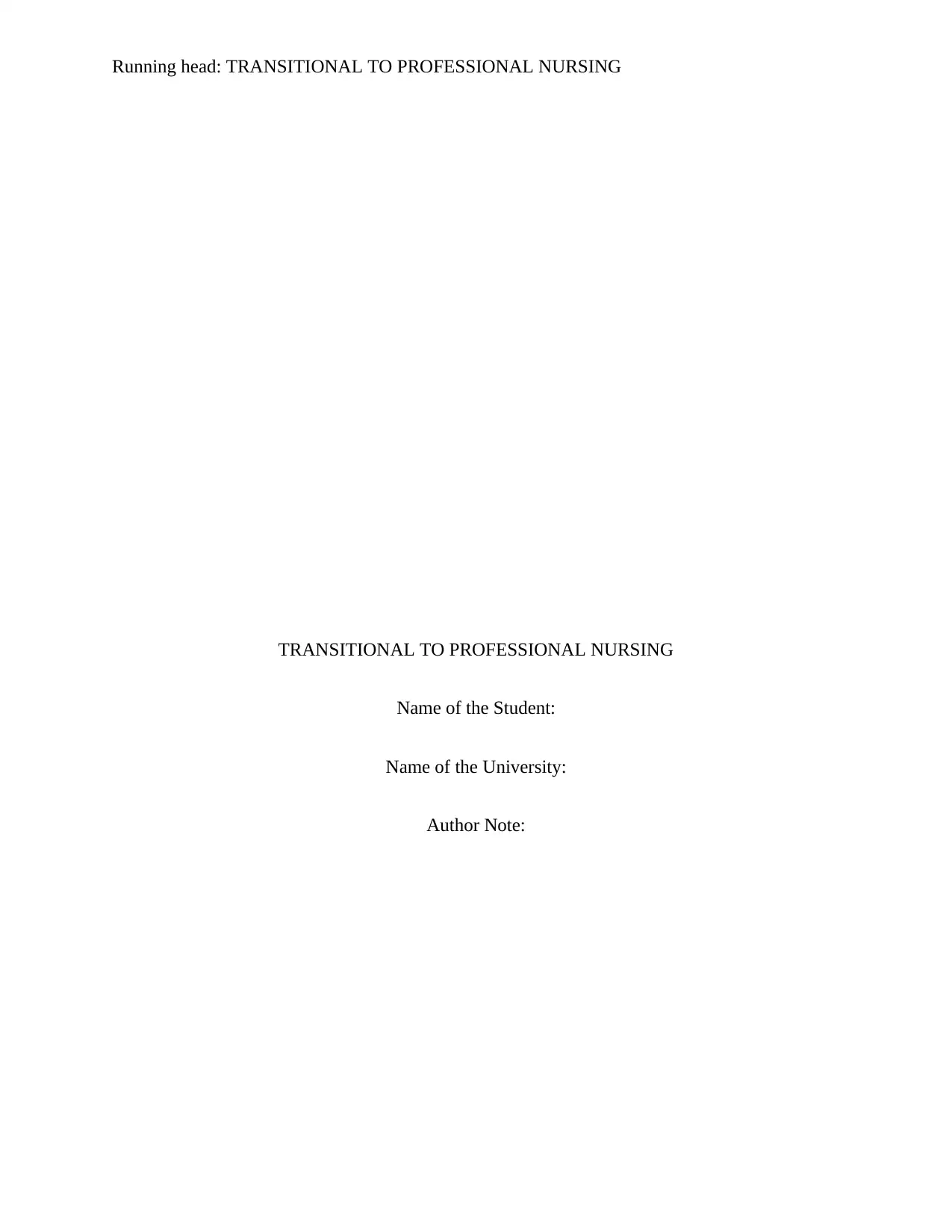
Running head: TRANSITIONAL TO PROFESSIONAL NURSING
TRANSITIONAL TO PROFESSIONAL NURSING
Name of the Student:
Name of the University:
Author Note:
TRANSITIONAL TO PROFESSIONAL NURSING
Name of the Student:
Name of the University:
Author Note:
Paraphrase This Document
Need a fresh take? Get an instant paraphrase of this document with our AI Paraphraser
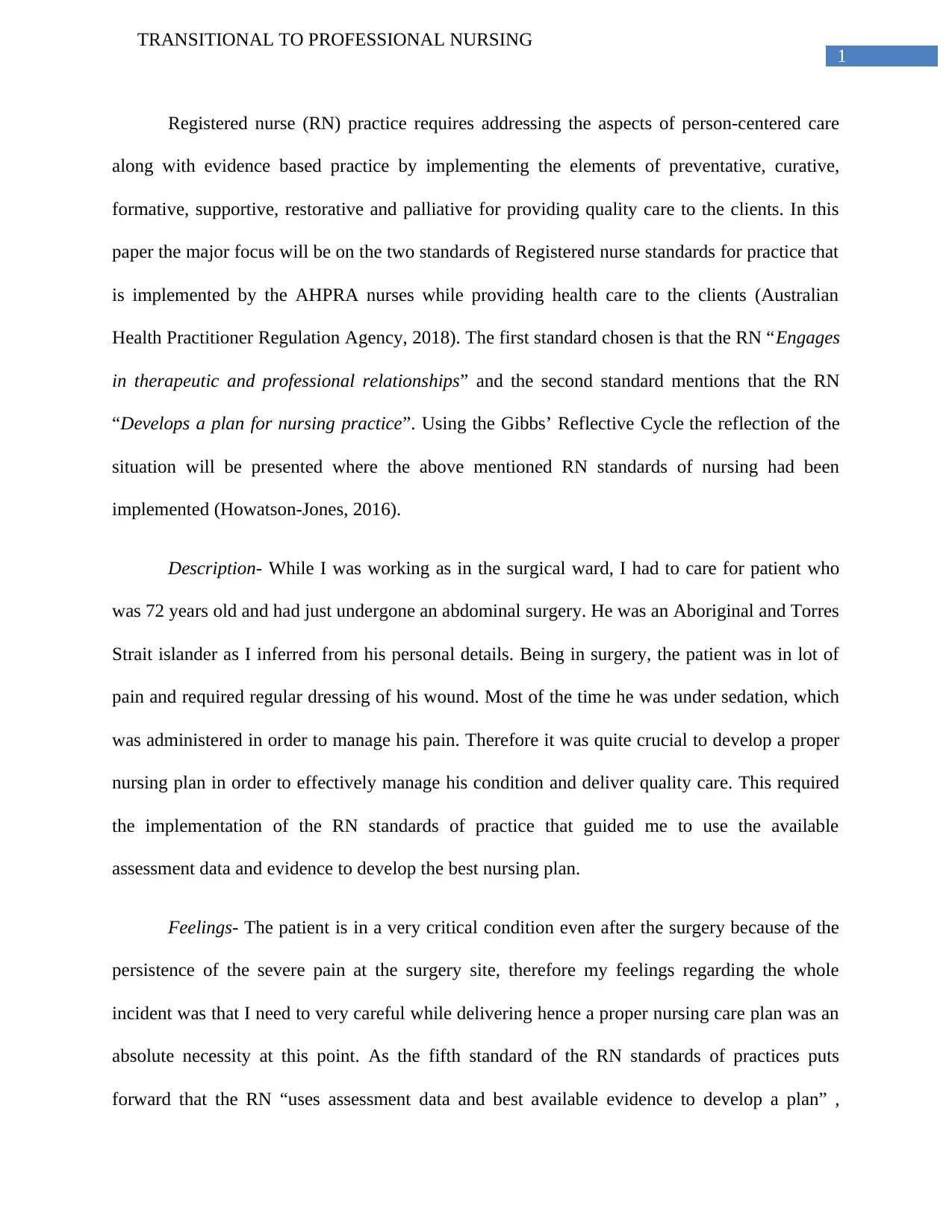
1
TRANSITIONAL TO PROFESSIONAL NURSING
Registered nurse (RN) practice requires addressing the aspects of person-centered care
along with evidence based practice by implementing the elements of preventative, curative,
formative, supportive, restorative and palliative for providing quality care to the clients. In this
paper the major focus will be on the two standards of Registered nurse standards for practice that
is implemented by the AHPRA nurses while providing health care to the clients (Australian
Health Practitioner Regulation Agency, 2018). The first standard chosen is that the RN “Engages
in therapeutic and professional relationships” and the second standard mentions that the RN
“Develops a plan for nursing practice”. Using the Gibbs’ Reflective Cycle the reflection of the
situation will be presented where the above mentioned RN standards of nursing had been
implemented (Howatson-Jones, 2016).
Description- While I was working as in the surgical ward, I had to care for patient who
was 72 years old and had just undergone an abdominal surgery. He was an Aboriginal and Torres
Strait islander as I inferred from his personal details. Being in surgery, the patient was in lot of
pain and required regular dressing of his wound. Most of the time he was under sedation, which
was administered in order to manage his pain. Therefore it was quite crucial to develop a proper
nursing plan in order to effectively manage his condition and deliver quality care. This required
the implementation of the RN standards of practice that guided me to use the available
assessment data and evidence to develop the best nursing plan.
Feelings- The patient is in a very critical condition even after the surgery because of the
persistence of the severe pain at the surgery site, therefore my feelings regarding the whole
incident was that I need to very careful while delivering hence a proper nursing care plan was an
absolute necessity at this point. As the fifth standard of the RN standards of practices puts
forward that the RN “uses assessment data and best available evidence to develop a plan” ,
TRANSITIONAL TO PROFESSIONAL NURSING
Registered nurse (RN) practice requires addressing the aspects of person-centered care
along with evidence based practice by implementing the elements of preventative, curative,
formative, supportive, restorative and palliative for providing quality care to the clients. In this
paper the major focus will be on the two standards of Registered nurse standards for practice that
is implemented by the AHPRA nurses while providing health care to the clients (Australian
Health Practitioner Regulation Agency, 2018). The first standard chosen is that the RN “Engages
in therapeutic and professional relationships” and the second standard mentions that the RN
“Develops a plan for nursing practice”. Using the Gibbs’ Reflective Cycle the reflection of the
situation will be presented where the above mentioned RN standards of nursing had been
implemented (Howatson-Jones, 2016).
Description- While I was working as in the surgical ward, I had to care for patient who
was 72 years old and had just undergone an abdominal surgery. He was an Aboriginal and Torres
Strait islander as I inferred from his personal details. Being in surgery, the patient was in lot of
pain and required regular dressing of his wound. Most of the time he was under sedation, which
was administered in order to manage his pain. Therefore it was quite crucial to develop a proper
nursing plan in order to effectively manage his condition and deliver quality care. This required
the implementation of the RN standards of practice that guided me to use the available
assessment data and evidence to develop the best nursing plan.
Feelings- The patient is in a very critical condition even after the surgery because of the
persistence of the severe pain at the surgery site, therefore my feelings regarding the whole
incident was that I need to very careful while delivering hence a proper nursing care plan was an
absolute necessity at this point. As the fifth standard of the RN standards of practices puts
forward that the RN “uses assessment data and best available evidence to develop a plan” ,
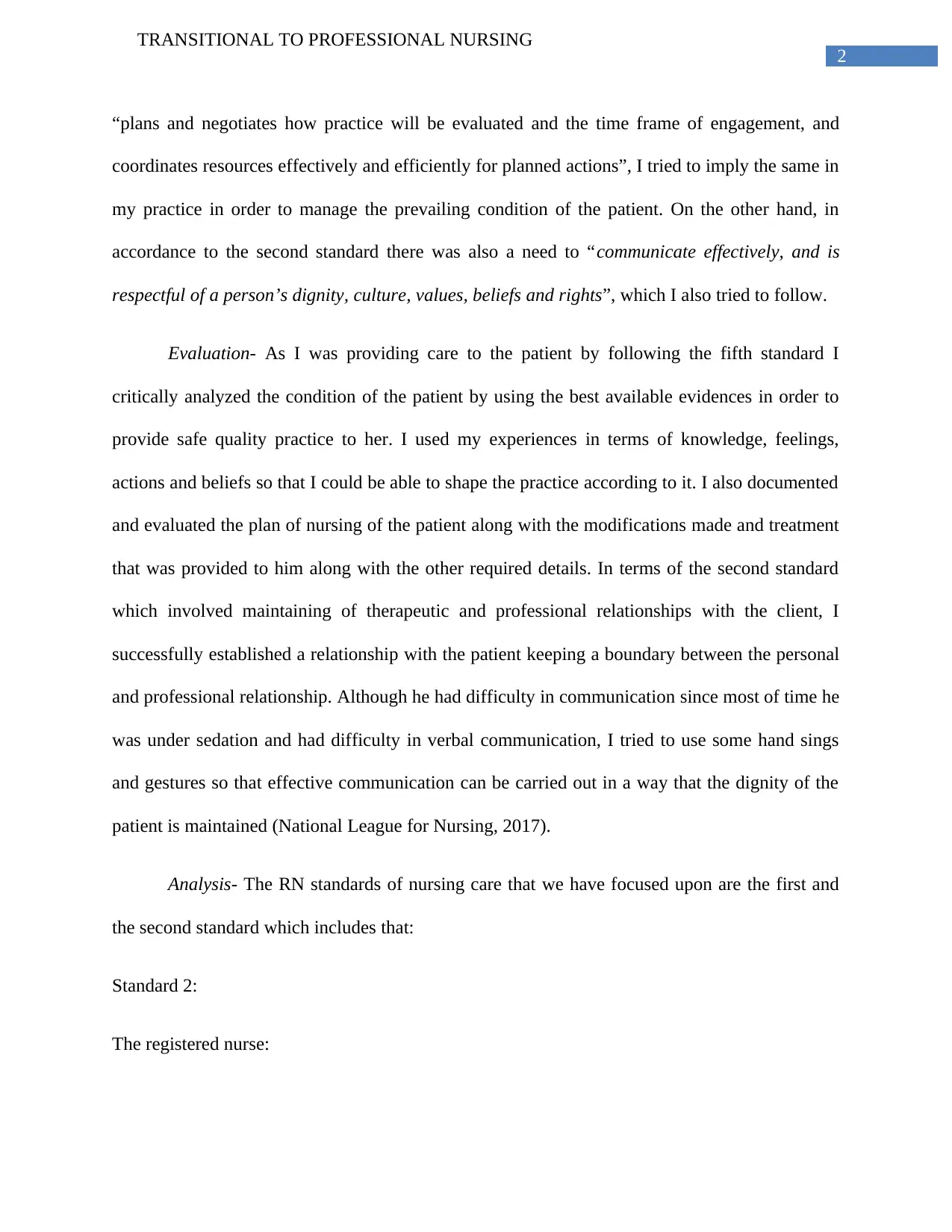
2
TRANSITIONAL TO PROFESSIONAL NURSING
“plans and negotiates how practice will be evaluated and the time frame of engagement, and
coordinates resources effectively and efficiently for planned actions”, I tried to imply the same in
my practice in order to manage the prevailing condition of the patient. On the other hand, in
accordance to the second standard there was also a need to “communicate effectively, and is
respectful of a person’s dignity, culture, values, beliefs and rights”, which I also tried to follow.
Evaluation- As I was providing care to the patient by following the fifth standard I
critically analyzed the condition of the patient by using the best available evidences in order to
provide safe quality practice to her. I used my experiences in terms of knowledge, feelings,
actions and beliefs so that I could be able to shape the practice according to it. I also documented
and evaluated the plan of nursing of the patient along with the modifications made and treatment
that was provided to him along with the other required details. In terms of the second standard
which involved maintaining of therapeutic and professional relationships with the client, I
successfully established a relationship with the patient keeping a boundary between the personal
and professional relationship. Although he had difficulty in communication since most of time he
was under sedation and had difficulty in verbal communication, I tried to use some hand sings
and gestures so that effective communication can be carried out in a way that the dignity of the
patient is maintained (National League for Nursing, 2017).
Analysis- The RN standards of nursing care that we have focused upon are the first and
the second standard which includes that:
Standard 2:
The registered nurse:
TRANSITIONAL TO PROFESSIONAL NURSING
“plans and negotiates how practice will be evaluated and the time frame of engagement, and
coordinates resources effectively and efficiently for planned actions”, I tried to imply the same in
my practice in order to manage the prevailing condition of the patient. On the other hand, in
accordance to the second standard there was also a need to “communicate effectively, and is
respectful of a person’s dignity, culture, values, beliefs and rights”, which I also tried to follow.
Evaluation- As I was providing care to the patient by following the fifth standard I
critically analyzed the condition of the patient by using the best available evidences in order to
provide safe quality practice to her. I used my experiences in terms of knowledge, feelings,
actions and beliefs so that I could be able to shape the practice according to it. I also documented
and evaluated the plan of nursing of the patient along with the modifications made and treatment
that was provided to him along with the other required details. In terms of the second standard
which involved maintaining of therapeutic and professional relationships with the client, I
successfully established a relationship with the patient keeping a boundary between the personal
and professional relationship. Although he had difficulty in communication since most of time he
was under sedation and had difficulty in verbal communication, I tried to use some hand sings
and gestures so that effective communication can be carried out in a way that the dignity of the
patient is maintained (National League for Nursing, 2017).
Analysis- The RN standards of nursing care that we have focused upon are the first and
the second standard which includes that:
Standard 2:
The registered nurse:
⊘ This is a preview!⊘
Do you want full access?
Subscribe today to unlock all pages.

Trusted by 1+ million students worldwide
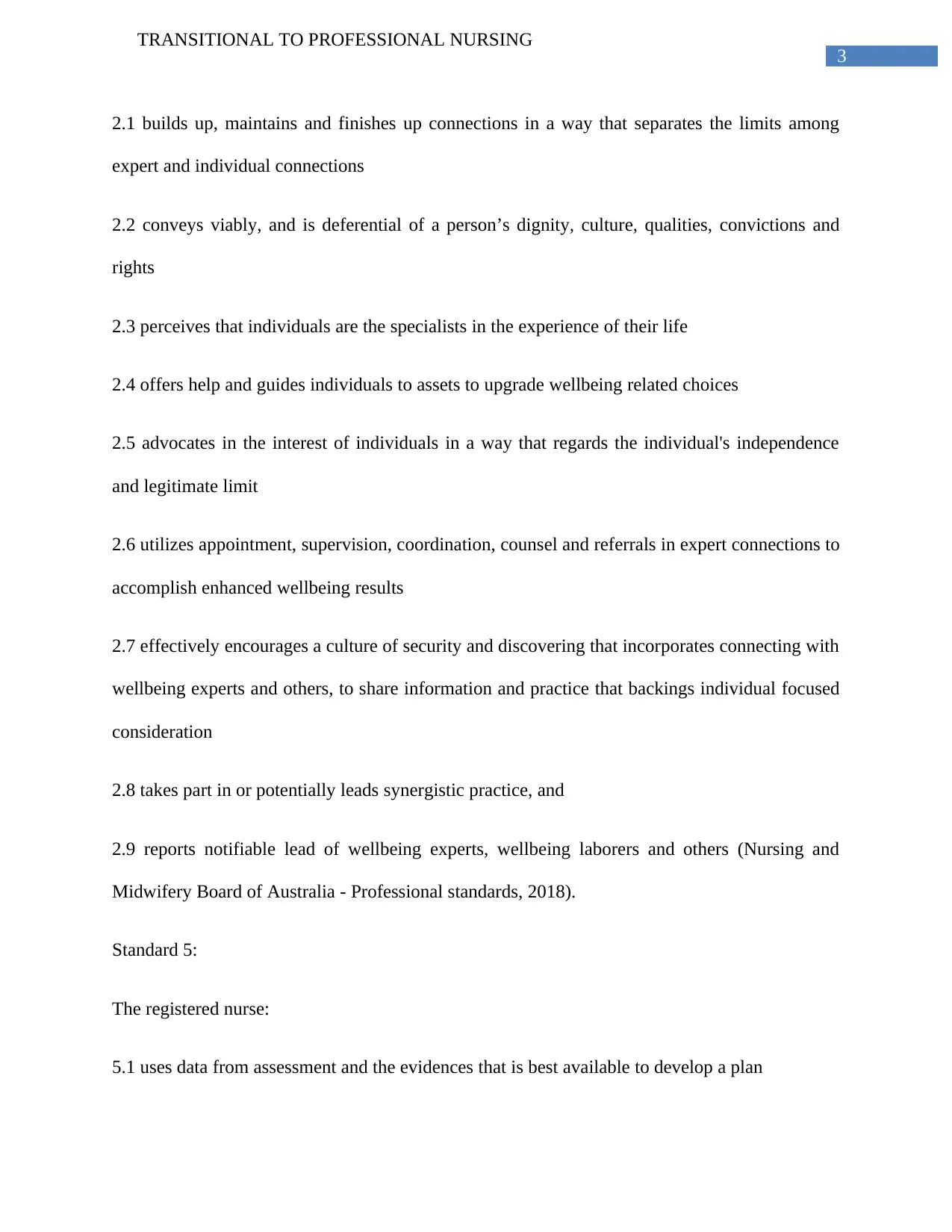
3
TRANSITIONAL TO PROFESSIONAL NURSING
2.1 builds up, maintains and finishes up connections in a way that separates the limits among
expert and individual connections
2.2 conveys viably, and is deferential of a person’s dignity, culture, qualities, convictions and
rights
2.3 perceives that individuals are the specialists in the experience of their life
2.4 offers help and guides individuals to assets to upgrade wellbeing related choices
2.5 advocates in the interest of individuals in a way that regards the individual's independence
and legitimate limit
2.6 utilizes appointment, supervision, coordination, counsel and referrals in expert connections to
accomplish enhanced wellbeing results
2.7 effectively encourages a culture of security and discovering that incorporates connecting with
wellbeing experts and others, to share information and practice that backings individual focused
consideration
2.8 takes part in or potentially leads synergistic practice, and
2.9 reports notifiable lead of wellbeing experts, wellbeing laborers and others (Nursing and
Midwifery Board of Australia - Professional standards, 2018).
Standard 5:
The registered nurse:
5.1 uses data from assessment and the evidences that is best available to develop a plan
TRANSITIONAL TO PROFESSIONAL NURSING
2.1 builds up, maintains and finishes up connections in a way that separates the limits among
expert and individual connections
2.2 conveys viably, and is deferential of a person’s dignity, culture, qualities, convictions and
rights
2.3 perceives that individuals are the specialists in the experience of their life
2.4 offers help and guides individuals to assets to upgrade wellbeing related choices
2.5 advocates in the interest of individuals in a way that regards the individual's independence
and legitimate limit
2.6 utilizes appointment, supervision, coordination, counsel and referrals in expert connections to
accomplish enhanced wellbeing results
2.7 effectively encourages a culture of security and discovering that incorporates connecting with
wellbeing experts and others, to share information and practice that backings individual focused
consideration
2.8 takes part in or potentially leads synergistic practice, and
2.9 reports notifiable lead of wellbeing experts, wellbeing laborers and others (Nursing and
Midwifery Board of Australia - Professional standards, 2018).
Standard 5:
The registered nurse:
5.1 uses data from assessment and the evidences that is best available to develop a plan
Paraphrase This Document
Need a fresh take? Get an instant paraphrase of this document with our AI Paraphraser
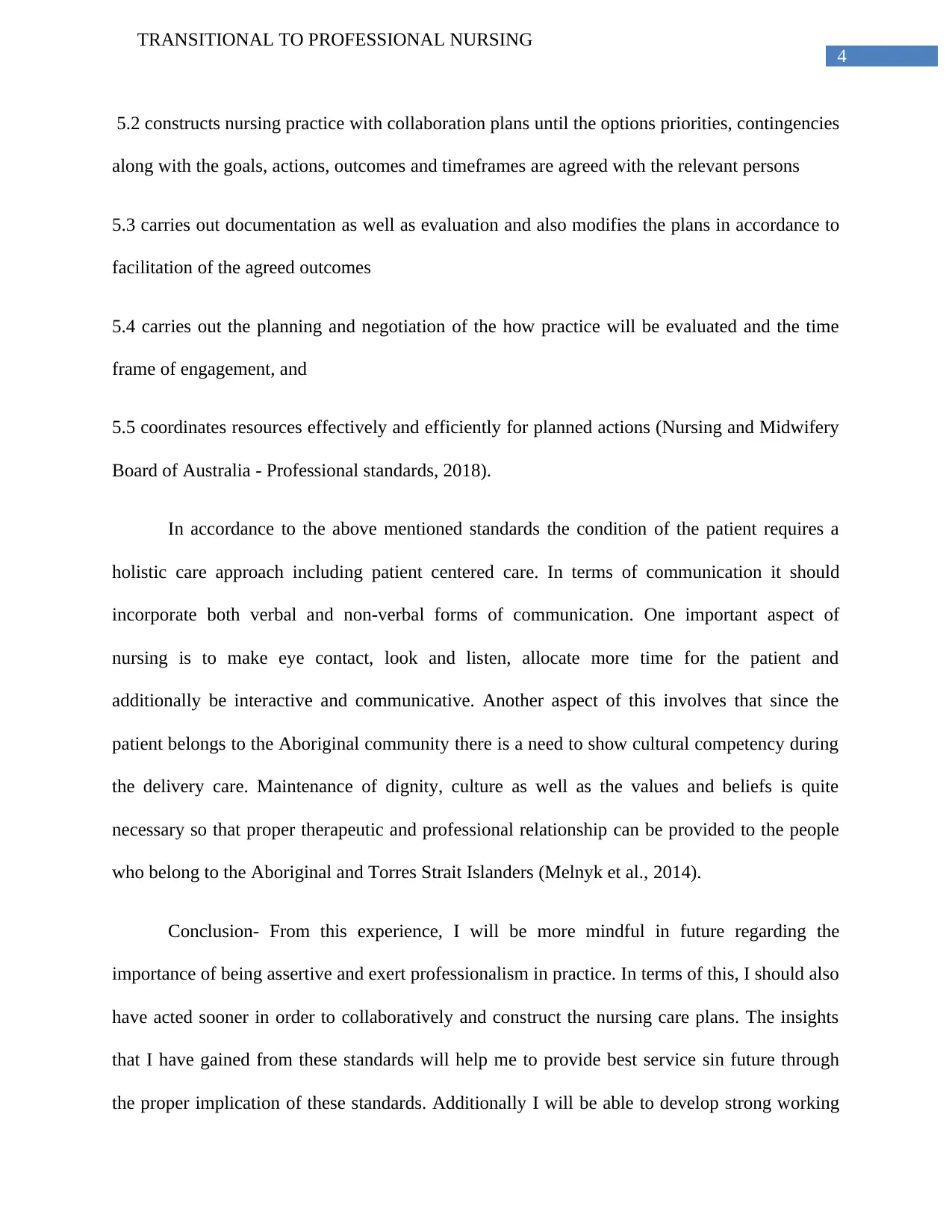
4
TRANSITIONAL TO PROFESSIONAL NURSING
5.2 constructs nursing practice with collaboration plans until the options priorities, contingencies
along with the goals, actions, outcomes and timeframes are agreed with the relevant persons
5.3 carries out documentation as well as evaluation and also modifies the plans in accordance to
facilitation of the agreed outcomes
5.4 carries out the planning and negotiation of the how practice will be evaluated and the time
frame of engagement, and
5.5 coordinates resources effectively and efficiently for planned actions (Nursing and Midwifery
Board of Australia - Professional standards, 2018).
In accordance to the above mentioned standards the condition of the patient requires a
holistic care approach including patient centered care. In terms of communication it should
incorporate both verbal and non-verbal forms of communication. One important aspect of
nursing is to make eye contact, look and listen, allocate more time for the patient and
additionally be interactive and communicative. Another aspect of this involves that since the
patient belongs to the Aboriginal community there is a need to show cultural competency during
the delivery care. Maintenance of dignity, culture as well as the values and beliefs is quite
necessary so that proper therapeutic and professional relationship can be provided to the people
who belong to the Aboriginal and Torres Strait Islanders (Melnyk et al., 2014).
Conclusion- From this experience, I will be more mindful in future regarding the
importance of being assertive and exert professionalism in practice. In terms of this, I should also
have acted sooner in order to collaboratively and construct the nursing care plans. The insights
that I have gained from these standards will help me to provide best service sin future through
the proper implication of these standards. Additionally I will be able to develop strong working
TRANSITIONAL TO PROFESSIONAL NURSING
5.2 constructs nursing practice with collaboration plans until the options priorities, contingencies
along with the goals, actions, outcomes and timeframes are agreed with the relevant persons
5.3 carries out documentation as well as evaluation and also modifies the plans in accordance to
facilitation of the agreed outcomes
5.4 carries out the planning and negotiation of the how practice will be evaluated and the time
frame of engagement, and
5.5 coordinates resources effectively and efficiently for planned actions (Nursing and Midwifery
Board of Australia - Professional standards, 2018).
In accordance to the above mentioned standards the condition of the patient requires a
holistic care approach including patient centered care. In terms of communication it should
incorporate both verbal and non-verbal forms of communication. One important aspect of
nursing is to make eye contact, look and listen, allocate more time for the patient and
additionally be interactive and communicative. Another aspect of this involves that since the
patient belongs to the Aboriginal community there is a need to show cultural competency during
the delivery care. Maintenance of dignity, culture as well as the values and beliefs is quite
necessary so that proper therapeutic and professional relationship can be provided to the people
who belong to the Aboriginal and Torres Strait Islanders (Melnyk et al., 2014).
Conclusion- From this experience, I will be more mindful in future regarding the
importance of being assertive and exert professionalism in practice. In terms of this, I should also
have acted sooner in order to collaboratively and construct the nursing care plans. The insights
that I have gained from these standards will help me to provide best service sin future through
the proper implication of these standards. Additionally I will be able to develop strong working
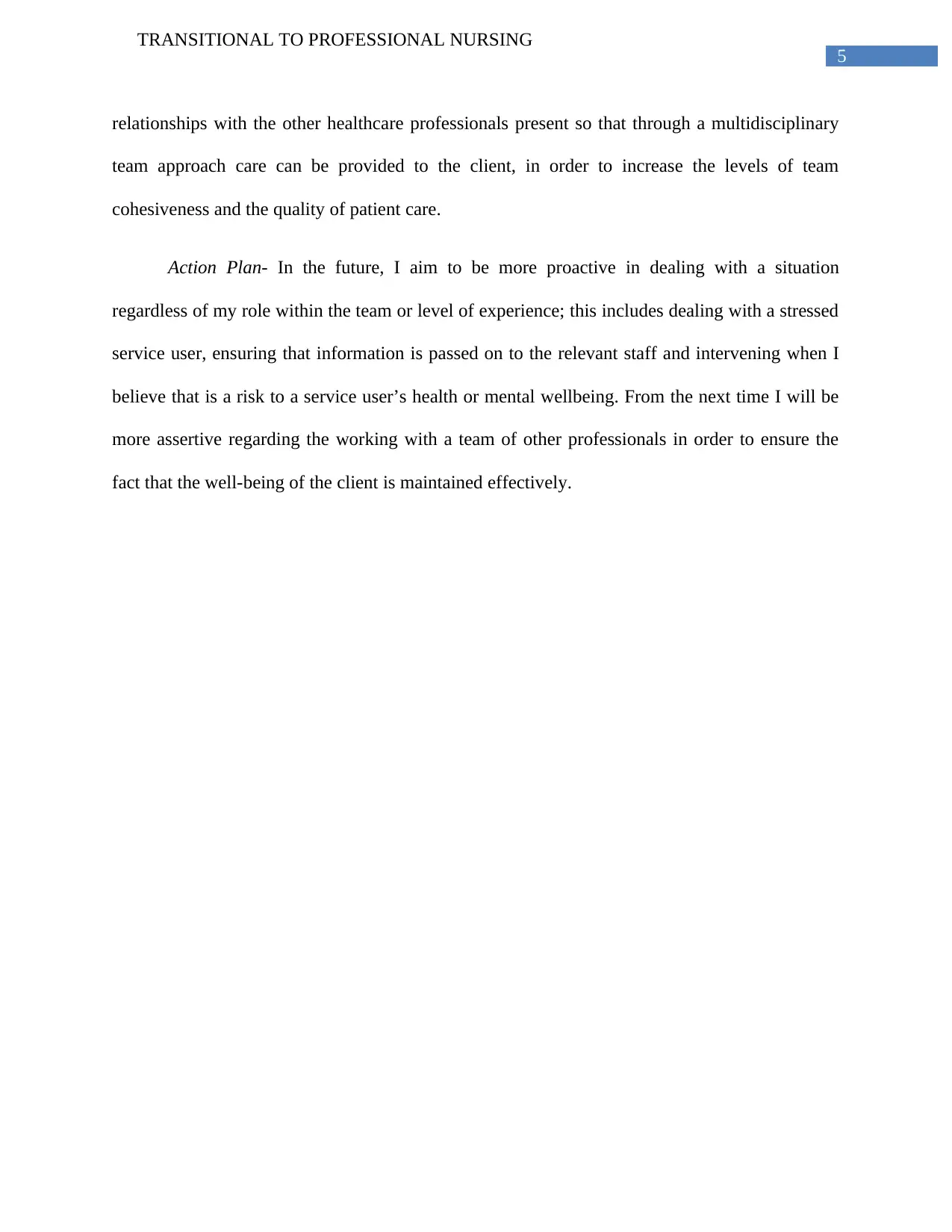
5
TRANSITIONAL TO PROFESSIONAL NURSING
relationships with the other healthcare professionals present so that through a multidisciplinary
team approach care can be provided to the client, in order to increase the levels of team
cohesiveness and the quality of patient care.
Action Plan- In the future, I aim to be more proactive in dealing with a situation
regardless of my role within the team or level of experience; this includes dealing with a stressed
service user, ensuring that information is passed on to the relevant staff and intervening when I
believe that is a risk to a service user’s health or mental wellbeing. From the next time I will be
more assertive regarding the working with a team of other professionals in order to ensure the
fact that the well-being of the client is maintained effectively.
TRANSITIONAL TO PROFESSIONAL NURSING
relationships with the other healthcare professionals present so that through a multidisciplinary
team approach care can be provided to the client, in order to increase the levels of team
cohesiveness and the quality of patient care.
Action Plan- In the future, I aim to be more proactive in dealing with a situation
regardless of my role within the team or level of experience; this includes dealing with a stressed
service user, ensuring that information is passed on to the relevant staff and intervening when I
believe that is a risk to a service user’s health or mental wellbeing. From the next time I will be
more assertive regarding the working with a team of other professionals in order to ensure the
fact that the well-being of the client is maintained effectively.
⊘ This is a preview!⊘
Do you want full access?
Subscribe today to unlock all pages.

Trusted by 1+ million students worldwide
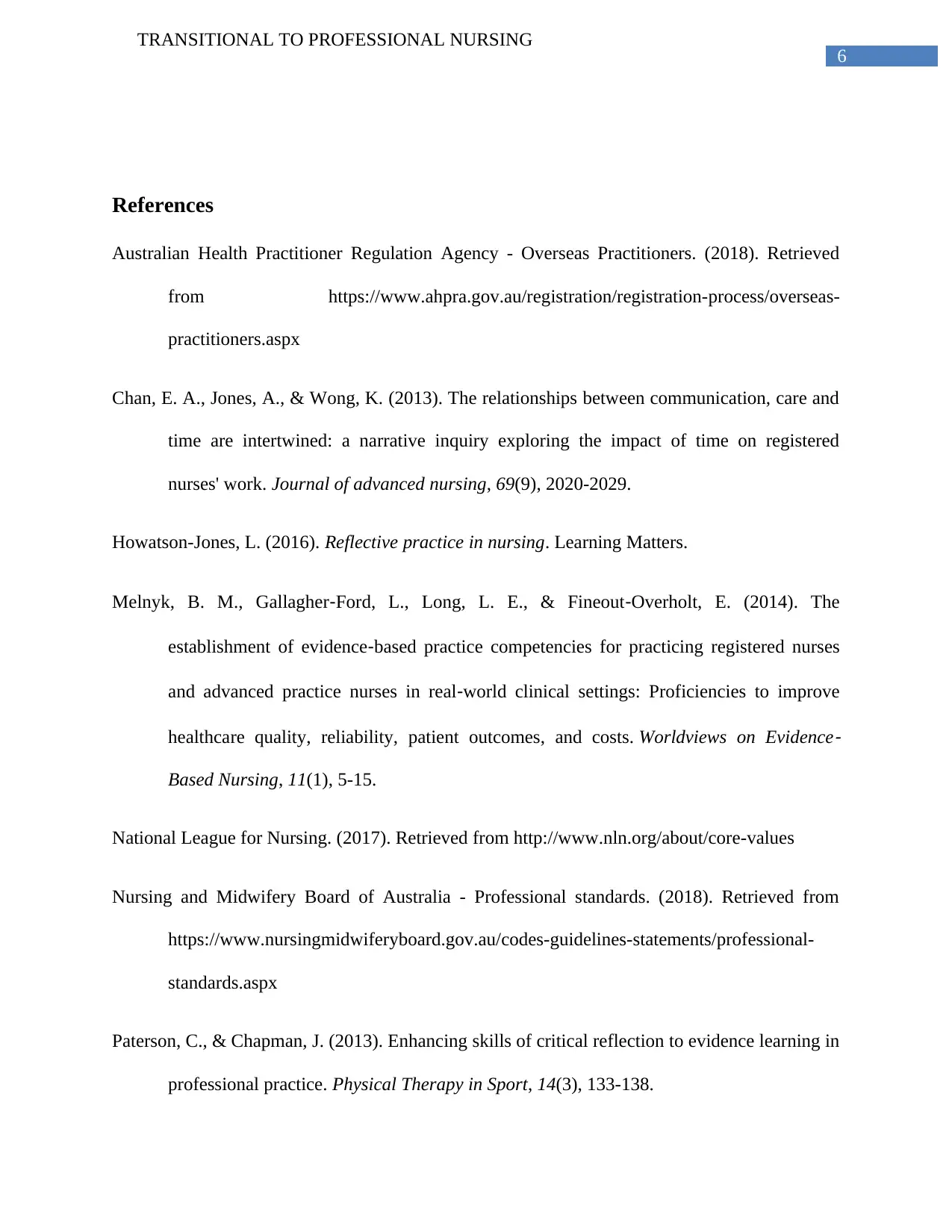
6
TRANSITIONAL TO PROFESSIONAL NURSING
References
Australian Health Practitioner Regulation Agency - Overseas Practitioners. (2018). Retrieved
from https://www.ahpra.gov.au/registration/registration-process/overseas-
practitioners.aspx
Chan, E. A., Jones, A., & Wong, K. (2013). The relationships between communication, care and
time are intertwined: a narrative inquiry exploring the impact of time on registered
nurses' work. Journal of advanced nursing, 69(9), 2020-2029.
Howatson-Jones, L. (2016). Reflective practice in nursing. Learning Matters.
Melnyk, B. M., Gallagher‐Ford, L., Long, L. E., & Fineout‐Overholt, E. (2014). The
establishment of evidence‐based practice competencies for practicing registered nurses
and advanced practice nurses in real‐world clinical settings: Proficiencies to improve
healthcare quality, reliability, patient outcomes, and costs. Worldviews on Evidence
‐
Based Nursing, 11(1), 5-15.
National League for Nursing. (2017). Retrieved from http://www.nln.org/about/core-values
Nursing and Midwifery Board of Australia - Professional standards. (2018). Retrieved from
https://www.nursingmidwiferyboard.gov.au/codes-guidelines-statements/professional-
standards.aspx
Paterson, C., & Chapman, J. (2013). Enhancing skills of critical reflection to evidence learning in
professional practice. Physical Therapy in Sport, 14(3), 133-138.
TRANSITIONAL TO PROFESSIONAL NURSING
References
Australian Health Practitioner Regulation Agency - Overseas Practitioners. (2018). Retrieved
from https://www.ahpra.gov.au/registration/registration-process/overseas-
practitioners.aspx
Chan, E. A., Jones, A., & Wong, K. (2013). The relationships between communication, care and
time are intertwined: a narrative inquiry exploring the impact of time on registered
nurses' work. Journal of advanced nursing, 69(9), 2020-2029.
Howatson-Jones, L. (2016). Reflective practice in nursing. Learning Matters.
Melnyk, B. M., Gallagher‐Ford, L., Long, L. E., & Fineout‐Overholt, E. (2014). The
establishment of evidence‐based practice competencies for practicing registered nurses
and advanced practice nurses in real‐world clinical settings: Proficiencies to improve
healthcare quality, reliability, patient outcomes, and costs. Worldviews on Evidence
‐
Based Nursing, 11(1), 5-15.
National League for Nursing. (2017). Retrieved from http://www.nln.org/about/core-values
Nursing and Midwifery Board of Australia - Professional standards. (2018). Retrieved from
https://www.nursingmidwiferyboard.gov.au/codes-guidelines-statements/professional-
standards.aspx
Paterson, C., & Chapman, J. (2013). Enhancing skills of critical reflection to evidence learning in
professional practice. Physical Therapy in Sport, 14(3), 133-138.
Paraphrase This Document
Need a fresh take? Get an instant paraphrase of this document with our AI Paraphraser
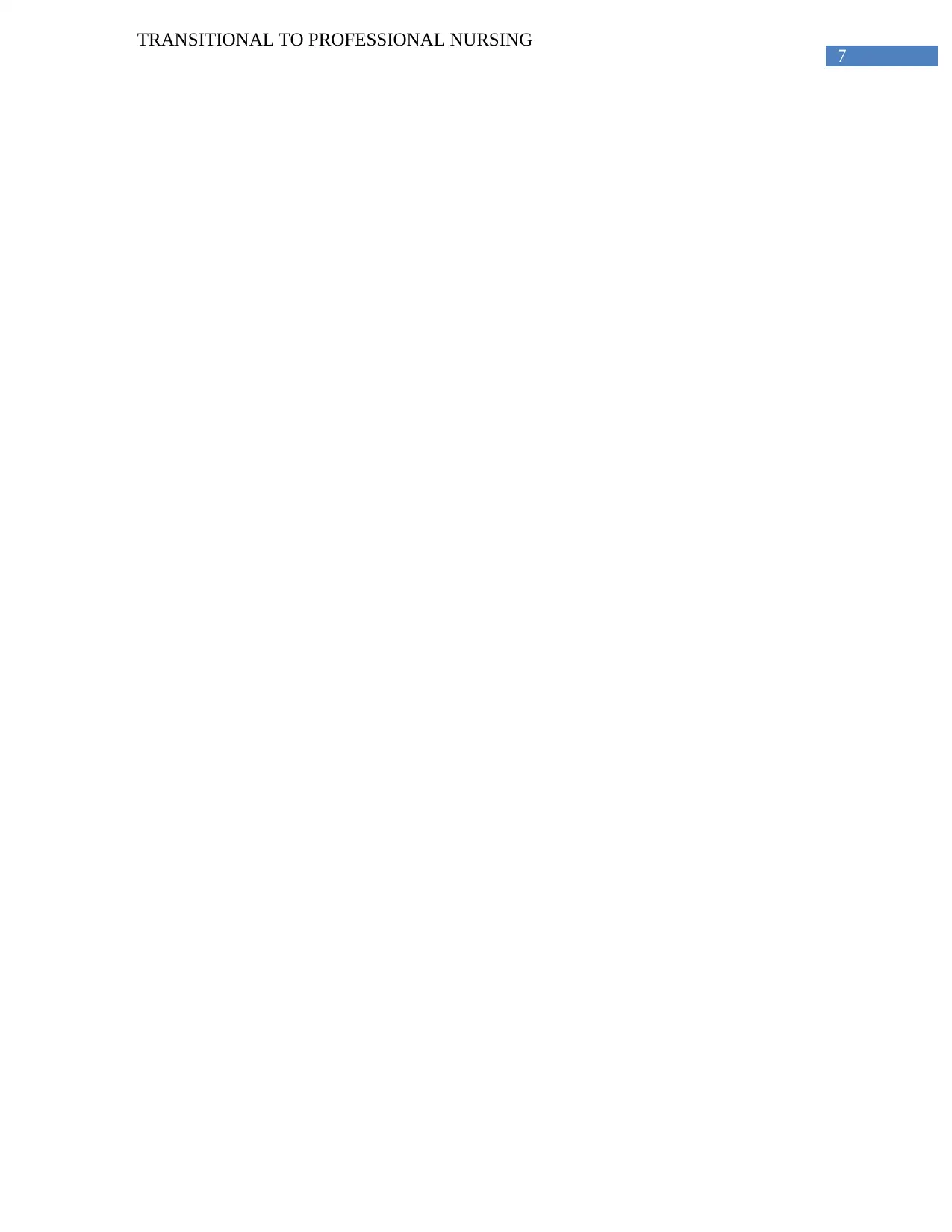
7
TRANSITIONAL TO PROFESSIONAL NURSING
TRANSITIONAL TO PROFESSIONAL NURSING
1 out of 8
Related Documents
Your All-in-One AI-Powered Toolkit for Academic Success.
+13062052269
info@desklib.com
Available 24*7 on WhatsApp / Email
![[object Object]](/_next/static/media/star-bottom.7253800d.svg)
Unlock your academic potential
Copyright © 2020–2025 A2Z Services. All Rights Reserved. Developed and managed by ZUCOL.


